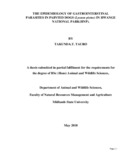Please use this identifier to cite or link to this item:
https://cris.library.msu.ac.zw//handle/11408/3828| Title: | The epidemiology of gastrointestrstinal parasites in painted dogs (Lycaon pictus) in Hwange National Park | Authors: | Tauro, Takunda . T | Keywords: | epidemiology painted dogs gastrointerstinal parasites Lycaon pictus gastrointestinal parasite co infection Hwange National Park |
Issue Date: | 2018 | Publisher: | Midlands State University | Abstract: | An epidemiological survey was conducted on the prevalence and risk factors associated with intestinal parasites of African Painted dog in Hwange National Park between June 2016 and July 2017. Centrifugal flotation and McMaster techniques were employed to obtain comprehensive data on the prevalence and diversity of gastrointestinal parasites observed in faecal samples collected from painted dogs. A total of 58 painted dogs were surveyed. Out of these, all were infected with at least one intestinal parasite and 10 parasite genera of gastrointestinal i.e. Alaria, Physolaptera, Isospora, Spirocerca, Dipylidium, Uncinaria, Toxoscaris, Toxocara, Taenia, Ancylostoma and Sarcocystis spp were recorded. Two parasites (Physolaptera and Spirocerca) have been reported for the first time in this study. Sarcocystis had the highest prevalence (28.2%) and intensity (629.18±113.01), while the lowest prevalence was for Physolaptera and Alaria spp (0.6% prevalence and 50± 0 intensity). Level of parasitism was statistically significant across all parasites species (F=0.036; p<0.05). The findings also revealed significant difference in intensity between packs (F= 0.037; p <0.05), no significant difference in level of parasitism between season (F=0.275; p > 0.05). Results were comparable basing on location but with no statistical significance (P=0.132). Coinfection was dominant with 82.8% dogs having multiple infection (>2 parasites) while 17.2% had single infection (<2 parasites). This coinfection affected intensity of parasitism with 27.1% of multi infected dogs having a heavy infection (>1000e.p. g) whilst 20% of single infected having a heavy infection. Overall, most parasite species were consistent with those found from studies in other regions of Africa and are likely a result of ingesting infected prey. The identification of two new parasite genera shows the scarcity of information on the subject. To our knowledge this study provides the most comprehensive survey of gastrointestinal parasite infection in painted dogs from this region to date and provides baseline data for future studies. | URI: | http://hdl.handle.net/11408/3828 |
| Appears in Collections: | Bsc Animal and Wildlife Sciences Honours Degree |
Files in This Item:
| File | Description | Size | Format | |
|---|---|---|---|---|
| Takunda Thesis final.pdf | Full Text | 1.83 MB | Adobe PDF |  View/Open |
Page view(s)
144
checked on Feb 26, 2025
Download(s)
122
checked on Feb 26, 2025
Google ScholarTM
Check
Items in MSUIR are protected by copyright, with all rights reserved, unless otherwise indicated.


